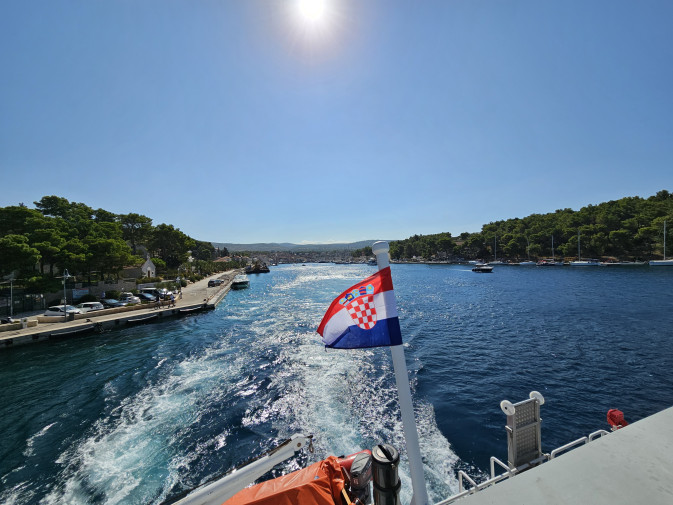
Brač: A jewel of the Adriatic Sea
Brač, an island nestled in the heart of the Adriatic Sea, stands as a testament to Croatia's stunning natural beauty and rich history. Known for its picturesque beaches and vibrant towns, this remarkable piece of land offers a captivating experience for every traveler. From the iconic Zlatni Rat Beach, whose shifting shape mesmerizes visitors, to the breathtaking views from Vidova Gora, the highest peak of all Adriatic islands, Brač is a paradise for nature lovers and adventurers alike.
An enchanting island in the Adriatic
As part of Croatia's extensive archipelago, Brač is the third-largest island in the Adriatic, covering an area of 396 square kilometers. Its terrain is as diverse as it is breathtaking, featuring rolling vineyards, dense pine forests, dramatic cliffs, and striking stone formations. The island enjoys a Mediterranean climate, with long, warm summers and mild winters, making it a year-round destination for travelers seeking both relaxation and adventure.
Explore the beaches of Brač
Tourists are often drawn to Brač for its stunning array of beaches, each offering a unique experience. The most famous is Zlatni Rat, often referred to as the "Golden Horn" due to its distinctive shape. Situated near the town of Bol, this beach extends into the Adriatic like an elegant tongue, constantly shifting form due to winds and tides. The smooth golden pebbles and crystal-clear waters create a serene and picturesque setting, perfect for sunbathing, swimming, and an array of water sports, including windsurfing and paddleboarding.
Beyond Zlatni Rat, visitors can explore lesser-known gems such as Lovrečina Bay, a sandy beach ideal for families, and Murvica Beach, a secluded cove surrounded by dramatic cliffs and lush vegetation, offering a peaceful retreat from the bustling tourist areas.
Discovering towns rich in history
The towns on Brač not only showcase stunning architecture but also tell tales steeped in history. Supetar, the island’s main town, attracts visitors with its charming harbor lined with quaint cafés, bustling markets, and historical sites such as the Church of the Annunciation, which features intricate stone carvings and Venetian-style architecture. Visitors can wander through its narrow streets, discovering remnants of Roman settlements and enjoying local delicacies at traditional konobas (taverns).
Another must-visit destination is Pučišća, renowned for its long-standing stone masonry tradition. This town is home to the Stonemasonry School of Brač, where skilled artisans have been shaping limestone for centuries. Milna, on the western coast, is a picturesque fishing village with sheltered bays that have historically provided safe harbor for sailors navigating the Adriatic. The town is a favorite stop for yachters looking to explore the nearby islets and hidden coves.
The legacy of Brač stone
Stone from Brač has long been treasured for its durability and beauty. The island’s white limestone has been used in some of the world’s most iconic structures, including Diocletian’s Palace in Split, the Parliament buildings in Vienna, and even parts of the White House in Washington, D.C. The island’s quarries have been active since Roman times, and the tradition of stone masonry remains a proud part of Brač’s identity today. Visitors can tour the quarries and witness firsthand the craftsmanship that continues to shape the island’s architectural heritage.
Blaca – A Monastic Retreat Hidden in the Rock
One of the most fascinating historical sites on Brač is the Blaca Monastery, carved into the rock and founded in the 16th century by Glagolitic priests. Established as a refuge from Ottoman conquests, the monastery eventually became a cultural and scientific center with a rich library, observatory, and valuable manuscripts. Today, Blaca is a must-visit destination for those wishing to explore the spiritual and historical heritage of the island.
Traveling to Brač via fast ferries
The accessibility of the island is now easier thanks to the TP Line catamaran services, which connect Brač to the mainland, offering daily connections from Split and Dubrovnik. The catamaran docks in Milna, making it easy to plan day trips or longer stays on the island.
These fast ferries are a vital link connecting Brač with mainland Croatia’s bustling ports like Split or Makarska, making short day trips or extended stays possible without hassle.
A tapestry of history woven into every corner
Brač boasts layers of history waiting to be unraveled by eager explorers. From ancient Illyrian ruins to medieval chapels perched atop hillsides offering panoramic views of surrounding seas—each site tells part of a rich historical saga woven through time.
The blend between historical intrigue paired with contemporary culture ensures that each visitor finds something unique during their stay on this enchanting island gem.
In conclusion, whether lured by tranquil beaches like Zlatni Rat or captivated by historic tales unfolding across scenic towns—the enchanting allure of Brač lies in its ability to offer serene adventures amid unparalleled natural landscapes found nowhere else along Croatia’s storied coastline.
Culinary delights and local traditions
No visit to Brač is complete without indulging in its culinary delights. The island is famous for its olive oil, considered some of the finest in Croatia. Visitors can tour local olive groves and sample traditional oils at family-owned mills. Lamb specialties, such as vitalac (skewered lamb offal wrapped in caul fat), are unique to Brač and offer a taste of the island’s authentic cuisine. Brač is also known for its excellent Plavac Mali wine, produced from indigenous grape varieties thriving in the island’s sun-drenched vineyards.

